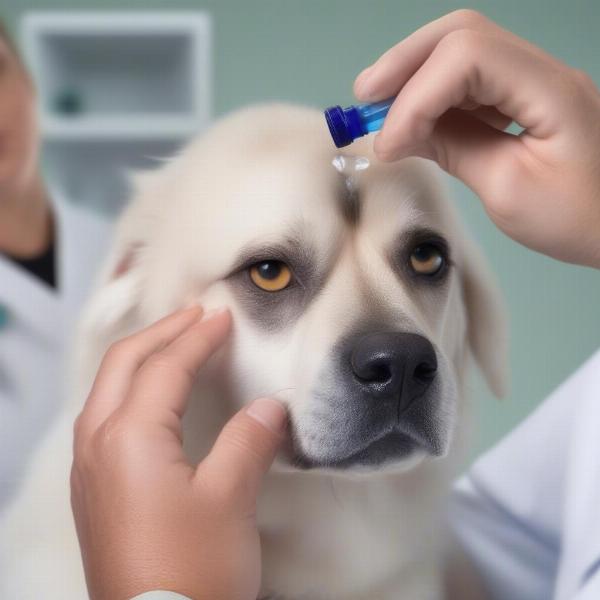Chloramphenicol eye drops are a common medication used to treat bacterial eye infections in dogs in the UK. Understanding when they are appropriate, how to administer them correctly, and potential side effects is crucial for responsible pet ownership. This guide provides a comprehensive overview of chloramphenicol eye drops for dogs in the UK, covering everything from usage and administration to potential risks and alternatives.
Understanding Chloramphenicol Eye Drops
Chloramphenicol is a broad-spectrum antibiotic effective against a wide range of bacteria. It works by inhibiting bacterial protein synthesis, thus stopping the infection from spreading. In the UK, chloramphenicol eye drops are typically prescribed by veterinarians for bacterial conjunctivitis, corneal ulcers, and other bacterial eye infections in dogs. It’s important to remember that chloramphenicol is not effective against viral or fungal infections.
 Chloramphenicol Eye Drops for Dogs
Chloramphenicol Eye Drops for Dogs
When are Chloramphenicol Eye Drops Necessary?
Symptoms of a bacterial eye infection in dogs can include redness, swelling, discharge (which may be watery, sticky, or pus-like), squinting, and excessive blinking. However, these symptoms can also be indicative of other eye conditions. Therefore, it’s crucial to seek veterinary advice before using any medication, including chloramphenicol. A vet will diagnose the underlying cause and determine the most appropriate treatment. Self-treating your dog’s eye infection could worsen the condition or delay appropriate treatment.
Administering Chloramphenicol Eye Drops
Your vet will provide specific instructions on the correct dosage and frequency of administration for your dog. Generally, a small amount of the solution is dropped into the affected eye(s) several times a day. It’s vital to follow these instructions precisely. Wash your hands thoroughly before and after administering the drops. Gently restrain your dog and tilt their head slightly upwards. Pull down the lower eyelid to form a small pouch, and instill the prescribed number of drops into the pouch. Avoid touching the tip of the bottle to the eye to prevent contamination.
Potential Side Effects and Precautions
While generally safe, chloramphenicol eye drops can occasionally cause mild side effects, such as temporary blurring of vision or slight irritation. In rare cases, more severe allergic reactions can occur. If you notice any unusual symptoms after administering the drops, contact your vet immediately. Inform your vet about any other medications your dog is taking, as interactions can occur.
Alternatives to Chloramphenicol
Several alternative antibiotic eye drops are available for dogs in the UK. Your vet can advise on the best option based on your dog’s specific condition and health status. Some alternatives include fusidic acid, gentamicin, and ciprofloxacin. Never switch or discontinue a prescribed medication without consulting your veterinarian.
Conclusion
Chloramphenicol eye drops can be an effective treatment for bacterial eye infections in dogs in the UK. However, it’s essential to consult a veterinarian for a proper diagnosis and treatment plan. Correct administration and monitoring for potential side effects are crucial for ensuring your dog’s safety and the effectiveness of the treatment. Remember, accurate diagnosis and professional veterinary guidance are essential for managing your dog’s eye health.
FAQ
- Can I use human chloramphenicol eye drops on my dog? No, you should never use human medications on your dog without veterinary guidance. Formulations and dosages can differ significantly.
- What should I do if my dog’s eye infection doesn’t improve? Contact your veterinarian immediately. They may need to adjust the medication or explore other treatment options.
- Can I buy chloramphenicol eye drops for dogs over the counter in the UK? No, chloramphenicol is a prescription-only medication in the UK and requires a veterinary prescription.
- How long does it take for chloramphenicol eye drops to work? Improvement is typically seen within a few days, but the full course of treatment must be completed as directed by your vet.
- What if I miss a dose? Administer the missed dose as soon as you remember. If it’s almost time for the next dose, skip the missed dose and continue with the regular schedule.
- Can chloramphenicol be used in pregnant or lactating dogs? Discuss this with your veterinarian, as there may be potential risks.
- Are there any home remedies for dog eye infections? While some home remedies might provide temporary relief, it’s crucial to consult a veterinarian for proper diagnosis and treatment.
ILM Dog is your trusted resource for expert dog care advice and guidance. We offer a wealth of information on dog breeds, health, training, nutrition, grooming, and much more. From puppy care to senior dog care, we cover every aspect of responsible dog ownership. For personalized advice and access to our premium resources, contact us today! Email: [email protected] Phone: +44 20-3965-8624. Visit ILM Dog for more information.